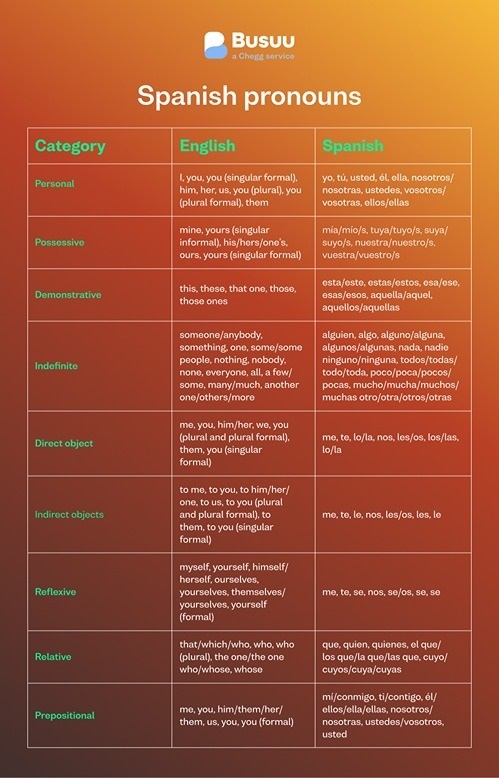Guide to Spanish Pronouns
We’ll take a look at some of the rules for using pronouns in Spanish correctly.
I want to learn...
Pronouns are essential to understanding who did what in a sentence. It’s simple: a pronoun is what’s used in a sentence instead of a name or noun. Examples of pronouns include: I, you, he, she, it, we, they, me, him, her, us, them.
In Spanish, pronouns are used the same way as in English; it's just where they're placed in the sentence that differs or the gender. By the time you finish reading this, you’ll be able to identify the subtle differences.
Here is a quick and simple guide when using Spanish pronouns.
Consider formal and informal Spanish pronouns
If you have been learning Spanish for some time, you’ll know that pronouns can be formal or informal. If you were not aware, there’s no need to panic — we’ll explain it quickly and easily.
Usted is used when you are talking to someone you want to show respect to. It is appropriate for an older person or someone in a leadership position. On the other hand, the pronoun tú is used within family, friends or acquaintances. See? As simple as one plus one.
Gender of nouns in Spanish
Before we move on, remember that Spanish nouns need to match what they’re replacing. That means that pronouns will change in number and gender.
So, when you see a pronoun that sometimes ends with an “a” (feminine) and other times with an “o” (masculine), it has to do with the gender of the noun being replaced.
The world of Spanish pronouns is big. We will categorize them for you and explain what they are used for. Let’s dive in!

9 Pronouns in Spanish
| Category | English | Spanish |
|---|---|---|
| 1. Personal: they replace who speaks, who listens, or who is being talked about. | I, you, you (singular formal), him, her, us, you (plural), you (plural formal), them | yo, tú, usted, él, ella, nosotros/nosotras, ustedes, vosotros/vosotras, ellos/ellas |
| 2. Possessive: they indicate possession or ownership. | mine, yours (singular informal), his/hers/one’s, ours, yours (singular formal) | mía/mío/s, tuya/tuyo/s, suya/suyo/s, nuestra/nuestro/s, vuestra/vuestro/s |
| 3. Demonstrative: they’re used to point out things | this, these, that one, those, those ones | esta/este, estas/estos, esa/ese, esas/esos, aquella/aquel, aquellos/aquellas |
| 4. Indefinite: they give indefinite information about what they replace. | someone/anybody, something, one, some/some people, nothing, nobody, none, everyone, all, a few/some, many/much, another one/others/more | alguien, algo, alguno/alguna, algunos/algunas, nada, nadie ninguno/ninguna, todos/todas/todo/toda, poco/poca/pocos/pocas, mucho/mucha/muchos/muchas otro/otra/otros/otras |
| 5. Direct object: they help replace the object of a sentence. | me, you, him/her, we, you (plural and plural formal), them, you (singular formal) | me, te, lo/la, nos, les/os, los/las, lo/la |
| 6. Indirect objects: they are used to make language more concise. | to me, to you, to him/her/one, to us, to you (plural and plural formal), to them, to you (singular formal) | me, te, le, nos, les/os, les, le |
| 7. Reflexive: they are used to indicate that a person performs an action to or for himself. | myself, yourself, himself/herself, ourselves, yourselves, themselves/yourselves, yourself (formal) | me, te, se, nos, se/os, se, se |
| 8. Relative: they help say additional info about the noun or pronoun. | that/which/who, who, who (plural), the one/the one who/whose, whose | que, quien, quienes, el que/los que/la que/las que, cuyo/cuyos/cuya/cuyas |
| 9. Prepositional: they give more info about how an object relates to someone or something else. | me, you, him/them/her/them, us, you, you (formal) | mí/conmigo, ti/contigo, él/ellos/ella/ellas, nosotros/nosotras, ustedes/vosotros, usted |
Now that we’ve had a bird’s eye view of the nine kinds of pronouns, let’s go a little deeper into explaining more about each group. Right now, we’re getting personal.
Personal pronouns in Spanish
Personal pronouns are the most used and the easiest ones to learn. They are he, she, we, you, etc. They take the place of the subject in a sentence.
Imagine a scenario where the subject is the protagonist of a sentence. The verb is conjugated so that it matches the subject. When using a pronoun, it’s the same thing.
Example:
- We got here first = Nosotros llegamos primero.
In this sentence “Nosotros” is masculine (although it can also be a mixed group of masculine and feminine). If the word was feminine, it would’ve been “Nosotras”.
Possessive pronouns in Spanish
What can be said about possessive pronouns that you may not already know? It doesn’t matter, we’ll explain anyway. A little grammar refresher never hurts anyone. So, these types of pronouns help establish ownership of something when it’s clear what you’re talking about. In a nutshell, they replace the noun entirely, so one simply states whose it is.
Example:
- May I borrow your cell phone? Mine ran out of battery.
In the sentence above, “mine” is replacing “my cell phone”. The context states what’s obvious, so specifying that you’re talking about a cell phone is not necessary — you simply need to mention what happened to yours. The same is true for Spanish possessive pronouns. Let’s see:
- The red suitcases are mine and the blue ones yours. = Las maletas rojas son mías y las azules tuyas.
Demonstrative pronouns in Spanish
Demonstrative pronouns are defined as words that show which person or thing is being referred to. They can be used for pointing out the one referred to and distinguishing it from others of the same class.
Let’s review them. Demonstrative pronouns replace the adjective and noun, or simply refer back to a previously mentioned/implied noun. It avoids repeating its name.
- He likes classic shoes, but I prefer these. = A él le gustan los zapatos clásicos, pero yo prefiero estos.
Each set of Spanish demonstrative pronouns corresponds with a different place word. Below are examples:
Place words in Spanish and their corresponding demonstrative pronoun
| English | Demonstrative pronouns in Spanish | Place words in Spanish |
|---|---|---|
| Here | este | aquí |
| There | ese | ahí |
| Over there | aquel | allí |
Direct object pronouns in Spanish
How can you replace the object in a sentence? Using direct object pronouns. These help us talk about a person, place or thing without having to repeat its name. We introduce the subject at the beginning of the sentence. Then we follow with a direct object pronoun. See below:
- Yesterday I saw Juan and I realized I missed him. = Ayer vi a Juan y me di cuenta de que lo extrañaba.
Indirect object pronouns in Spanish
Indirect object pronouns have a different role. They are indirect if they are affected by the action, but they are not the main object in the sentence. Let’s look at the examples below:
-
Charlie bought a slice of pizza. = Charlie compró una porción de pizza.
-
Charlie bought a slice of pizza for you. = Charlie compró una porción de pizza para ti.
As you can see from the first sentence, Charlie bought a pizza. The pizza is the recipient of the action (which in this case is “buying”), so it’s the direct object here.
In the second sentence, however, “you” is the indirect object pronoun. In this case, Charlie is buying a pizza for you. You’re indirectly affected by his act of buying a pizza. It’s indirect because the main recipient of the action is the pizza.
Although these two types of pronouns are similar, we can see that their roles are different. So, how does it work in Spanish? See below:
- Bring us something from your trip. = Tráenos algo de tu viaje.
Spanish reflexive pronouns
Reflexive pronouns are used in sentences in which the subject and the object refer to the same person. That means that the action that the subject performs affects them, instead of someone else. Describing a daily routine is a good example of the use of these types of pronouns.
See the example below:
- Every day I wake [myself] up. = Yo me levanto todos los días.
Spanish relative pronouns
It can be said that Spanish relative pronouns are like a bridge. They’re used to connect ideas. Basically, they add more information about the person or object.
- The man that came to fix my washer didn’t want to charge me. = El hombre que vino a arreglar la lavadora no quiso cobrarme.
English relative pronouns work very similarly, although in English they’re not mandatory.
Spanish prepositional pronouns
The name says it all: prepositional pronouns go after a preposition, like por, para, de, hacia, etc.
These are easy to remember. Only two of them are different — the rest are actually the same as personal pronouns, but in this case they come after a preposition. The ones that change are the first person singular (mí/conmigo) and the second person singular informal (ti/contigo).
Here are some examples of those two:
-
She was dancing in front of me. = Estaba bailando frente a mí.
-
Can I come with you to the game? = ¿Puedo ir contigo al partido?
When talking about these types of pronouns, there is one special preposition to keep very present: con.
In Spanish, when we want to communicate that we’re doing something with someone we don’t say con mí or con ti, we say conmigo or contigo. This is a special rule that will make all the difference when you start using your Spanish.
Feeling more confident about Spanish pronouns? We hope so! Why not learn the differences between Spanish in Spain and Spanish in Latin America, too?
Start learning Spanish or other languages today!
Here at Busuu, our award-winning online Spanish course teaches you simple, everyday language you’ll use. Click on the button below to start learning Spanish – or one of the other 14 languages we offer!

